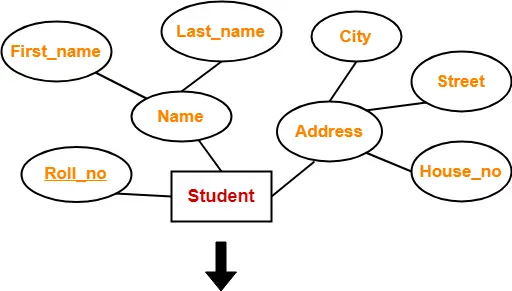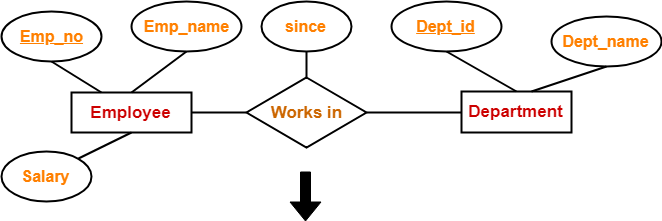Converting ER Diagrams to Tables-
After designing an ER Diagram,
- ER diagram is converted into the tables in relational model.
- This is because relational models can be easily implemented by RDBMS like MySQL , Oracle etc.
Following rules are used for converting an ER diagram into the tables-
Rule-01: For Strong Entity Set With Only Simple Attributes-
A strong entity set with only simple attributes will require only one table in relational model.
- Attributes of the table will be the attributes of the entity set.
- The primary key of the table will be the key attribute of the entity set.
Example-

Schema : Student ( Roll_no , Name , Sex )
Also Read- Entity Sets in DBMS
Rule-02: For Strong Entity Set With Composite Attributes-
- A strong entity set with any number of composite attributes will require only one table in relational model.
- While conversion, simple attributes of the composite attributes are taken into account and not the composite attribute itself.
Example-

| Roll_no | First_name | Last_name | House_no | Street | City |
Schema : Student ( Roll_no , First_name , Last_name , House_no , Street , City )
Also Read- Types of Attributes in DBMS
Rule-03: For Strong Entity Set With Multi Valued Attributes-
A strong entity set with any number of multi valued attributes will require two tables in relational model.
- One table will contain all the simple attributes with the primary key.
- Other table will contain the primary key and all the multi valued attributes.
Example-

Rule-04: Translating Relationship Set into a Table-
A relationship set will require one table in the relational model.
Attributes of the table are-
- Primary key attributes of the participating entity sets
- Its own descriptive attributes if any.
Set of non-descriptive attributes will be the primary key.
Example-

Schema : Works in ( Emp_no , Dept_id , since )
NOTE-
If we consider the overall ER diagram, three tables will be required in relational model-
- One table for the entity set "Employee"
- One table for the entity set "Department"
- One table for the relationship set "Works in"
Rule-05: For Binary Relationships With Cardinality Ratios-
The following four cases are possible-
Case-01: Binary relationship with cardinality ratio m:n
Case-02: Binary relationship with cardinality ratio 1:n
Case-03: Binary relationship with cardinality ratio m:1
Case-04: Binary relationship with cardinality ratio 1:1
Also read- Cardinality Ratios in DBMS
Case-01: For Binary Relationship With Cardinality Ratio m:n

Here, three tables will be required-
- A ( a1 , a2 )
- R ( a1 , b1 )
- B ( b1 , b2 )
Case-02: For Binary Relationship With Cardinality Ratio 1:n

Here, two tables will be required-
- A ( a1 , a2 )
- BR ( a1 , b1 , b2 )
NOTE- Here, combined table will be drawn for the entity set B and relationship set R.
Case-03: For Binary Relationship With Cardinality Ratio m:1

Here, two tables will be required-
- AR ( a1 , a2 , b1 )
- B ( b1 , b2 )
NOTE- Here, combined table will be drawn for the entity set A and relationship set R.
Case-04: For Binary Relationship With Cardinality Ratio 1:1

Here, two tables will be required. Either combine 'R' with 'A' or 'B'
Way-01:
- AR ( a1 , a2 , b1 )
- B ( b1 , b2 )
Way-02:
- A ( a1 , a2 )
- BR ( a1 , b1 , b2 )
Thumb Rules to Remember
While determining the minimum number of tables required for binary relationships with given cardinality ratios, following thumb rules must be kept in mind-
- For binary relationship with cardinality ration m : n , separate and individual tables will be drawn for each entity set and relationship.
- For binary relationship with cardinality ratio either m : 1 or 1 : n , always remember "many side will consume the relationship" i.e. a combined table will be drawn for many side entity set and relationship set.
- For binary relationship with cardinality ratio 1 : 1 , two tables will be required. You can combine the relationship set with any one of the entity sets.
Rule-06: For Binary Relationship With Both Cardinality Constraints and Participation Constraints-
- Cardinality constraints will be implemented as discussed in Rule-05.
- Because of the total participation constraint, foreign key acquires NOT NULL constraint i.e. now foreign key can not be null.
Case-01: For Binary Relationship With Cardinality Constraint and Total Participation Constraint From One Side-

Because cardinality ratio = 1 : n , so we will combine the entity set B and relationship set R.
Then, two tables will be required-
- A ( a1 , a2 )
- BR ( a1 , b1 , b2 )
Because of total participation, foreign key a1 has acquired NOT NULL constraint, so it can't be null now.
Case-02: For Binary Relationship With Cardinality Constraint and Total Participation Constraint From Both Sides-
If there is a key constraint from both the sides of an entity set with total participation, then that binary relationship is represented using only single table.

Here, Only one table is required.
- ARB ( a1 , a2 , b1 , b2 )
Rule-07: For Binary Relationship With Weak Entity Set-
Weak entity set always appears in association with identifying relationship with total participation constraint.

Here, two tables will be required-
- A ( a1 , a2 )
- BR ( a1 , b1 , b2 )
Next Article- Practice Problems On Converting ER Diagrams to Tables
Get more notes and other study material of Database Management System (DBMS).
Watch video lectures by visiting our YouTube channel LearnVidFun.
Summary

Article Name
ER Diagrams to Tables
Description
ER diagram is converted into the tables so that it can be easily implemented by any Relational Database Management System. We use the following rules for converting ER diagrams to tables.
Author
Akshay Singhal
Publisher Name
Gate Vidyalay
Publisher Logo

Source: https://www.gatevidyalay.com/er-diagrams-to-tables/
Posted by: casandrataubere0193567.blogspot.com